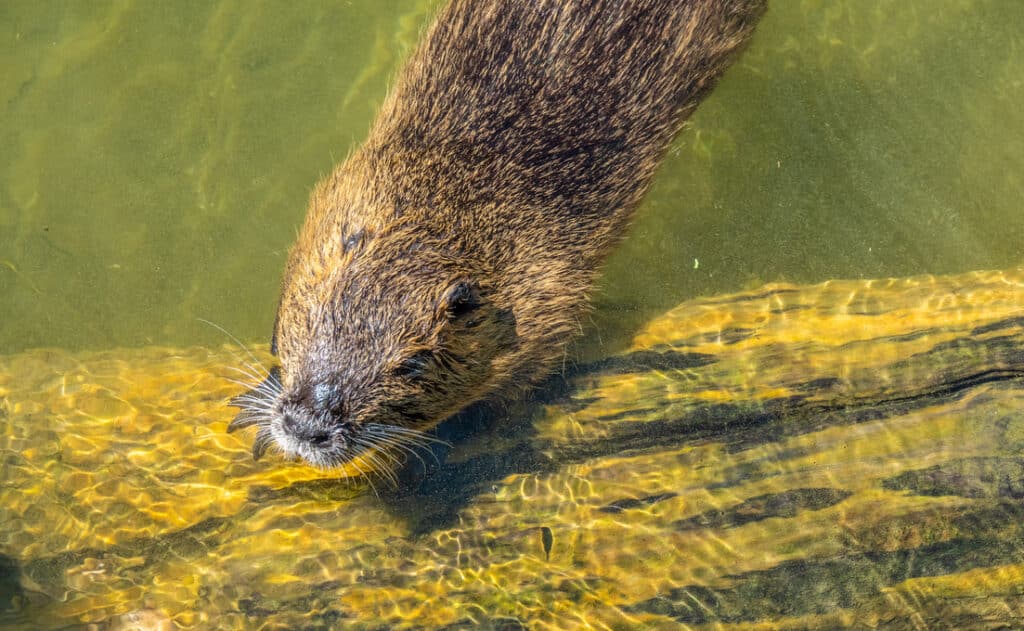Facts about the Eurasian Beaver
Scientific name: Castor fiber
At a glance
- Once widespread in the UK, Beavers were over-hunted and became extinct here in the 16th century.
- Reintroduction programmes are now underway to restore ‘nature’s engineer’ to our waterways.
- Licences to kill Beavers and remove their dams have been enthusiastically embraced.

Large, covered in dense fur, gnawing down trees with orange-enamelled incisors, building dams, or slapping its paddle shaped tail on the water as a warning of predators, beavers are a familiar staple of natural history programmes.
Nearly all of those films will have been taken in North America though and feature the widespread Castor canadensis, one of just two species of beaver worldwide.
While both Eurasian and North American Beavers have essentially the same habits and look very similar (Eurasian beavers are generally slightly smaller than North American Beavers with a larger, squarer head and longer, narrower muzzles), the reason ‘our’ beavers don’t feature so often is that they are so rare.
Once widespread (as the name suggests) across Eurasia, the beaver was hunted to near-extinction for its meat, its soft fur and a substance called castoreum which was collected from the glands of beavers and once widely used as a vanilla-like flavouring in foods and cigarettes and as a carnal, animalic note in perfumes (where it’s still used to day, natural castoreum has been replaced by a synthetic form).
Hunting was unregulated and so commonplace that the last beavers in the UK were wiped out during the 16th century and by the turn of the 20th century only about 1,200 beavers survived in eight relict populations in the whole of Europe and Asia. Habitat loss, especially the drying of wetlands, compounded the collapse.
Fast forward to the present and beavers are a European Protected Species (EPS) in Europe under the EU Habitats Directive, and because of the positive effects their dam-building has on the environment are recognised as a ‘keystone species’ (an organism that helps hold ecosystems together). The pools that back up behind their dams (or ‘lodges’, because these huge structures are also homes to beavers) are valuable for a huge range of other species too, including Otters, the scarce Water Vole and Water Shrew, (the rapidly declining) Common Frog and Common Toad, and birds including the Common Teal and the Red-listed Woodcock. Craneflies, water beetles and dragonflies in turn support breeding fish and insect-eating birds and bats and a host of invertebrates use the standing dead wood.

Just by doing what comes naturally, these remarkable animals also prevent soil eroded from fields from being washed out to sea, trap carbon and nutrients (improving water quality downstream), and slow the flow of water helping to ameliorate flooding.
Critically important to degraded ecosystems, small-scale reintroductions of what was no longer considered a native species have taken place in suitable localities in Scotland (near Argyll and along the Tay and Forth catchments) and along the River Otter in Devon. Protection for beavers here has come very slowly, but in May 2019 the Eurasian Beaver was added to the Habitats Regulations in Scotland and from October 2022 the species will be classed as native in England and fully protected, paving the way for licensed wild releases beyond enclosures.
While conservationists and rewilders praise the beaver as ‘ecosystem engineers’, not everyone welcomes the reintroduction programmes that have been cautiously (in other words far too slowly) allowed to take place.
Anglers, for instance, have complained that beavers would eat ‘their’ fish even though beavers feed entirely on plant matter, or that their dams would block salmon heading upstream: in fact there is zero evidence for that and the still, clear pools beavers create are perfect for breeding fish.
Farmers have been concerned that beavers might flood productive land along rivers where beavers have been introduced, so grants have been made available to mitigate any losses and other landowners that provide camping on their land have reported an uptick in business because of the public wanting to see beavers at work.

While the future for the beaver in the UK does look to be a little more secure, licences to kill them and remove their dams are available and have been enthusiastically embraced. In May 2022, NatureScot released the latest beaver licensing figures which showed that in 2021 a total of 120 beavers were removed from so-called ‘problem areas’ in Tayside: 87 were killed (compared with 115 in 2020) and .33 trapped and moved to licenced projects. These figures represent around 10% of the total estimated beaver population in Scotland.
Despite their new status in England, the government revealed in September 2022 that under pressure from the NFU farmers would be allowed to shoot beavers as a ‘last resort’ (which will inevitably be taken to mean ‘Shoot first, ask questions later’).
Conservationists reacted furiously. Renowned beaver expert Derek Gow was quoted in The Observer saying: “It is completely and utterly wrong to kill them. Beavers change landscapes for the better. They assist in times of drought and with slowing flow in times of flood. We should treasure beavers for all they offer and move them carefully where they will assist the land. We should not kill a single beaver.”
